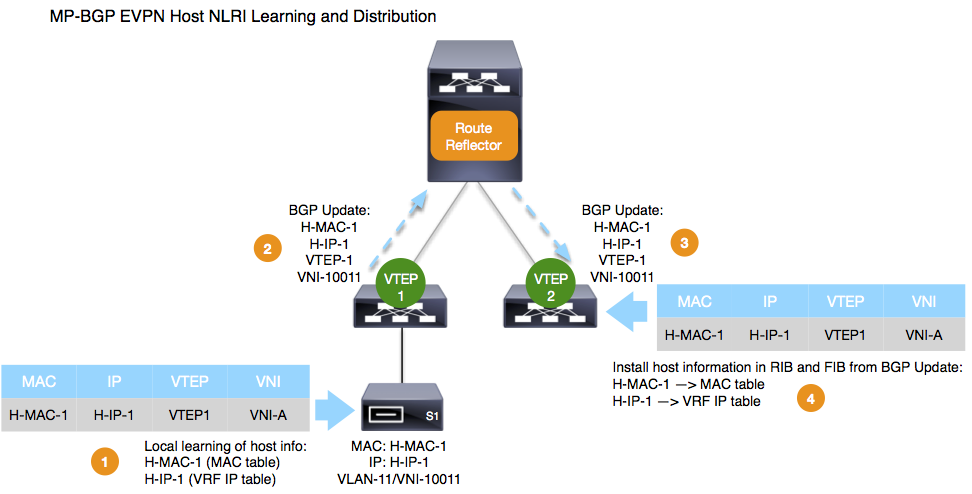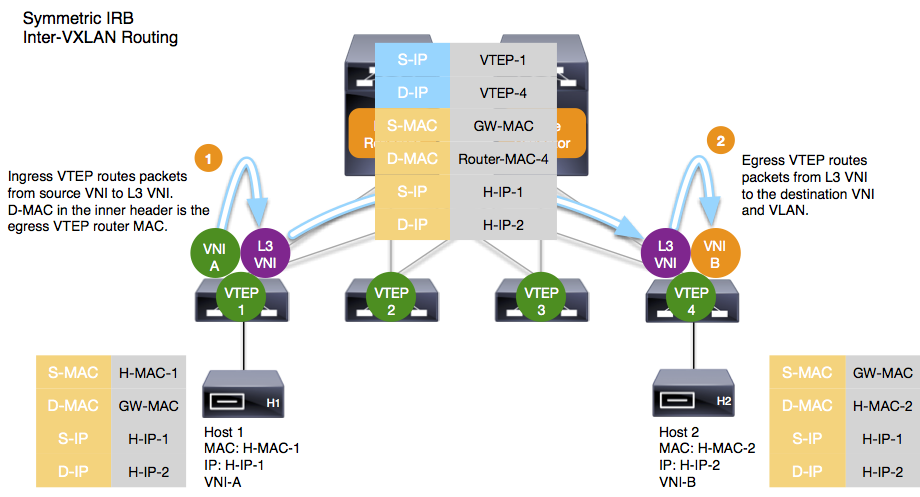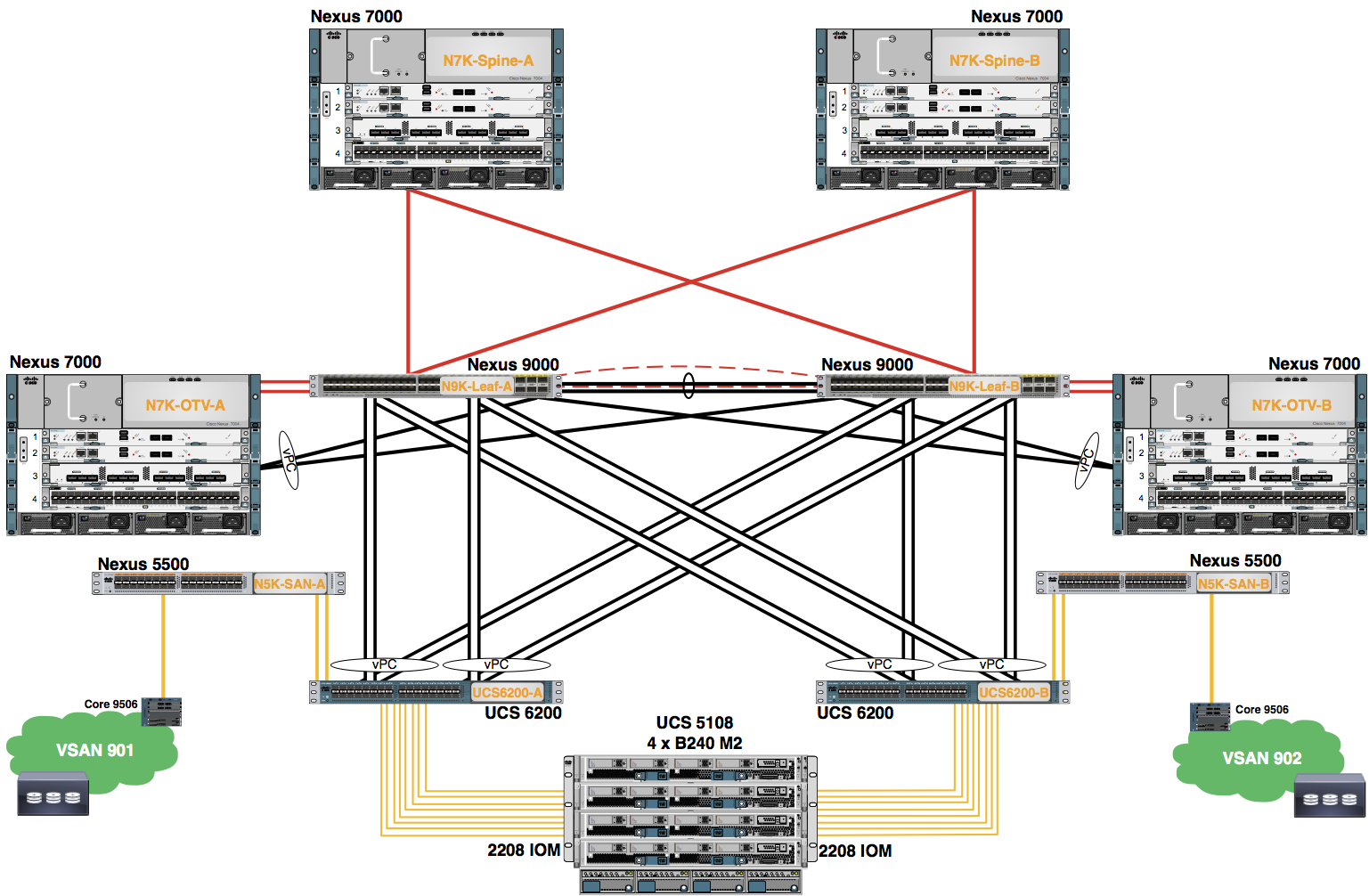Lab 1
Lab 1: Configure VXLAN EVPN
In this lab we configure Virtual Extensible LAN (VXLAN) with the MP-BGP EVPN control plane.

Virtual Extensible LAN (VXLAN) is an overlay technology for network virtualization. It provides Layer-2 extension over a shared Layer-3 underlay infrastructure network by using MAC address in IP User Datagram Protocol (MAC in IP/UDP) tunneling encapsulation. The purpose of obtaining Layer-2 extension in the overlay network is to overcome the limitations of physical server racks and geographical location boundaries to achieve flexibility for workload placement within a data center or between different data centers.
VXLAN offers the following benefits:
- Flexible placement of multitenant segments throughout the data center: It provides a solution to extend Layer 2 segments over the underlying shared network infrastructure so that tenant workload can be placed across physical pods in the data center.
- Higher scalability to address more Layer 2 segments: VLANs use a 12-bit VLAN ID to address Layer 2 segments, which results in limiting scalability of only 4094 VLANs. VXLAN uses a 24-bit segment ID known as the VXLAN network identifier (VNID), which enables up to 16 million VXLAN segments to coexist in the same administrative domain.
- Better utilization of available network paths in the underlying infrastructure: VLAN uses the Spanning Tree Protocol for loop prevention, which ends up not using half of the network links in a network by blocking redundant paths. In contrast, VXLAN packets are transferred through the underlying network based on its Layer 3 header and can take complete advantage of Layer 3 routing, equal-cost multipath (ECMP) routing, and link aggregation protocols to use all available paths.
The initial IETF VXLAN standards (RFC 7348) defined a multicast-based flood-and-learn VXLAN without a control plane. It relies on data-driven flood-and-learn behavior for remote VXLAN tunnel endpoint (VTEP) peer discovery and remote end-host learning. The overlay broadcast, unknown unicast, and multicast (BUM) traffic is encapsulated into multicast VXLAN packets and transported to remote VTEP switches through the underlay multicast forwarding. Flooding in such a deployment can present a challenge for the scalability of the solution. The requirement to enable multicast capabilities in the underlay network also presents a challenge as some organizations do not want to enable multicast in their data centers or WAN networks.
To overcome the limitations of the flood-and-learn VXLAN as defined in RFC 7348, organizations can use Multiprotocol Border Gateway Protocol Ethernet Virtual Private Network (MP-BGP EVPN) as the control plane for VXLAN. MP-BGP EVPN has been defined by the IETF as the standards-based control plane for VXLAN overlays. The MP-BGP EVPN control plane provides protocol-based VTEP peer discovery and distribution of end-host reachability information that allows more scalable VXLAN overlay network designs suitable for private and public clouds. The MP-BGP EVPN control plane introduces a set of features that reduces or eliminates traffic flooding in the overlay network and enables optimal forwarding for both west-east and south-north traffic.
MP-BGP EVPN is a control protocol for VXLAN based on industry standards. It introduces control-plane learning for end hosts behind remote VTEPs. It provides control-plane and data-plane separation and a unified control plane for both Layer-2 and Layer-3 forwarding in a VXLAN overlay network. The MP-BGP EVPN control plane offers the following main benefits:
- The MP-BGP EVPN protocol is based on industry standards, allowing multivendor interoperability.
- It enables control-plane learning of end-host Layer-2 and Layer-3 reachability information, enabling organizations to build more robust and scalable VXLAN overlay networks.
- It uses the decade-old MP-BGP VPN technology to support scalable multitenant VXLAN overlay networks.
- The EVPN address family carries both Layer-2 and Layer-3 reachability information, thus providing integrated bridging and routing in VXLAN overlay networks.
- It minimizes network flooding through protocol-based host MAC/IP route distribution and Address Resolution Protocol (ARP) suppression on the local VTEPs.
- It provides optimal forwarding for east-west and north-south traffic and supports workload mobility with the distributed anycast function.
- It provides VTEP peer discovery and authentication, mitigating the risk of rogue VTEPs in the VXLAN overlay network.
- It provides mechanisms for building active-active multihoming at Layer-2.
IP Transport Devices Running MP-BGP EVPN
IP transport devices provide IP routing in the underlay network. By running the MP-BGP EVPN protocol, they become part of the VXLAN control plane and distribute the MP-BGP EVPN routes among their MP-BGP EVPN peers through updates. Devices might be MP-iBGP EVPN peers or route reflectors, or MP External BGP (MP-eBGP) EVPN peers. For data forwarding, IP transport devices perform IP routing based only on the outer IP address of a VXLAN encapsulated packet. They don’t need to support the VXLAN data encapsulation and decapsulation functions.
VTEPs Running MP-BGP EVPN
VTEPs running MP-BGP EVPN need to support both the control-plane and data-plane functions. In the control plane, they initiate MP-BGP EVPN routes to advertise their locally learned hosts. They receive MP-BGP EVPN updates from their peers and install the EVPN routes in their forwarding tables. For data forwarding, they encapsulate host traffic into VXLAN and send it over the IP underlay network. In the reverse direction, they receive VXLAN encapsulated traffic from other VTEPs, decapsulate it, and forward the traffic with native Ethernet encapsulation toward the host.
MP-BGP EVPN NLRI and L2VPN EVPN Address Family
Like other network routing control protocols, MP-BGP EVPN is designed to distribute network layer reachability information (NLRI) for the network. A unique feature of EVPN NLRI is that it includes both the Layer-2 and Layer-3 reachability information for end hosts that reside in the EVPN VXLAN overlay network. In other words, it advertises both MAC and IP addresses of EVPN VXLAN end hosts. This capability forms the basis for VXLAN integrated bridging and routing support.



Symmetric IRB
Cisco NX-OS implements symmetric IRB for its scalability advantages and simplified Layer-2 and Layer-3 multitenancy support. With symmetric IRB, both the ingress and egress VTEPs perform Layer-2 and Layer-3 lookups. However, with symmetric IRB, the ingress VTEP doesn’t need to know the destination VNI for inter-VNI routing. Therefore, VTEPs don’t need to learn and maintain MAC address information for the remote hosts attached to egress VNIs for which it doesn’t have local hosts. This approach results in better utilization of the MAC address table and ARP adjacencies on a VTEP. Symmetric IRB introduces some new logical constructs: • Layer-3 VNI: Each tenant VRF instance is mapped to a unique Layer-3 VNI in the network. This mapping needs to be consistent on all the VTEPs in network. All inter-VXLAN routed traffic is encapsulated with the Layer-3 VNI in the VXLAN header and provides the VRF context for the receiving VTEP. The receiving VTEP uses this VNI to determine the VRF context in which the inner IP packet needs to be forwarded. This VNI also provides the basis for enforcing Layer-3 segmentation in the data plane. • VTEP router MAC address: Each VTEP has a unique system MAC address that other VTEPs can use for inter-VNI routing. This MAC address is referred to here as the router MAC address. The router MAC address is used as the inner destination MAC address for the routed VXLAN packet. As shown below, when a packet is sent from L2 VNI A to L2 VNI B, the ingress VTEP routes the packet to the Layer-3 VNI. It rewrites the inner destination MAC address to the egress VTEP’s router MAC address and encodes the Layer-3 VNI in the VXLAN header. After the egress VTEP receives the encapsulated VXLAN packet, it first decapsulates the packet by removing the VXLAN header. Then it looks at the inner packet header. Because the destination MAC address in the inner packet header is its own MAC address, it performs a Layer-3 routing lookup. The Layer-3 VNI in the VXLAN header provides the VRF context in which this routing lookup is performed.

Multitenancy in MP-BGP EVPN
As an extension to the existing MP-BGP, MP-BGP EVPN inherits the support for multitenancy with VPN using the virtual routing and forwarding (VRF) construct. In MP-BGP EVPN, multiple tenants can co-exist and share a common IP transport network while having their own separate VPNs in the VXLAN overlay network.

Similar to the VPNv4 address-family in the BGP MPLS-based IP VPN (RFC 4364), the L2VPN EVPN address-family for EVPN uses route distinguishers (RDs) to maintain uniqueness among identical routes in different VRF instances, and uses route targets (RTs) to define the policies that determine how routes are advertised and shared by different VRF instances. A route distinguisher is an 8-bit octet number used to distinguish one set of routes (one VRF instance) from another. It is a unique number prepended to each route so that if the same route is used in several different VRF instances, BGP can treat them as distinct routes. The route distinguisher is transmitted along with the route through MP-BGP when EVPN routes are exchanged with MP-BGP peers.
Route targets can be applied to a VRF instance to control the import and export of routes between this instance and other VRF instances. The route-target attributes for a route are distributed in the form of a BGP extended community attribute, so the BGP configuration on the devices that run MP-BGP EVPN must be enabled to generate or process extended community attributes. In the Cisco NX-OS implementation, the BGP route distinguisher and route target can be generated automatically for ease of configuration. The BGP route distinguisher can be derived automatically from the VNI and BGP router ID of the VTEP switch, and the BGP route target can be generated automatically as the BGP AS: VNI. Alternatively, you also can manually configure the BGP route distinguisher and route target. If all the MP-BGP EVPN VTEPs in a network are Cisco Nexus switch platforms, the recommended approach is to use autogenerated route-distinguisher and route-target values. If multiple vendors’ VTEP devices are interoperating, the recommended approach is to manually configure the values to avoid problems caused by the differences in vendors’ implementations. For eBGP deployment scenarios in which VTEPs are in different BGP domains, the BGP route targets must be manually assigned.
Built-in multitenancy support is an advantage of MP-BGP EVPN VXLAN compared to multicast-based flood-and-learn VXLAN and other Layer-2 extension technologies without multitenancy capabilities. It makes VXLAN technology more suitable for cloud networks, which are deployed using the multitenant model.
VXLAN EVPN Support on Cisco Nexus 9000 and Nexus 7000 Series Switches
Starting in Cisco NX-OS 7.0(3)I1(1), the Cisco Nexus 9300 platform switches support both the MP-BGP EVPN control-plane functions and the VTEP data-plane functions. The Cisco Nexus 9500 platform switches support the MP-BGP EVPN control-plane functions. The VTEP data-plane functions have been added to the Cisco Nexus 9500 platform switches in Cisco NX-OS release 7.0(3)I1(2). The Cisco Nexus 9300 and 9500 platforms both support inter-VXLAN routing in hardware. Starting in Cisco NX-OS 7.2(0)D1(1) with an F3 series line card, the Cisco Nexus 7x00 platform switches support both the MP-BGP EVPN control-plane functions and the VTEP data-plane functions. Starting in Cisco NX-OS 7.3(0)DX(1) with an M3 series line card, the Cisco Nexus 7x00 platform switches support the MP-BGP EVPN control-plane functions. The Cisco Nexus 7x00 platforms support inter-VXLAN routing in hardware.

